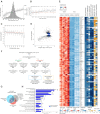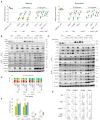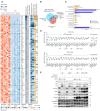DREAM and RB cooperate to induce gene repression and cell-cycle arrest in response to p53 activation
- PMID: 31400114
- PMCID: PMC6753476
- DOI: 10.1093/nar/gkz635
DREAM and RB cooperate to induce gene repression and cell-cycle arrest in response to p53 activation
Abstract
Most human cancers acquire mutations causing defects in the p53 signaling pathway. The tumor suppressor p53 becomes activated in response to genotoxic stress and is essential for arresting the cell cycle to facilitate DNA repair or to initiate apoptosis. p53-induced cell cycle-arrest is mediated by expression of the CDK inhibitor p21WAF1/Cip1, which prevents phosphorylation and inactivation of the pocket proteins RB, p130, and p107. In a hypophosphorylated state, pocket proteins bind to E2F factors forming RB-E2F and DREAM transcriptional repressor complexes. Here, we analyze the influence of RB and DREAM on p53-induced gene repression and cell-cycle arrest. We show that abrogation of DREAM function by knockout of the DREAM component LIN37 results in a reduced repression of cell-cycle genes. We identify the genes repressed by the p53-DREAM pathway and describe a set of genes that is downregulated by p53 independent of LIN37/DREAM. Most strikingly, p53-dependent repression of cell-cycle genes is completely abrogated in LIN37-/-;RB-/- cells leading to a loss of the G1/S checkpoint. Taken together, we show that DREAM and RB are key factors in the p53 signaling pathway to downregulate a large number of cell-cycle genes and to arrest the cell cycle at the G1/S transition.
© The Author(s) 2019. Published by Oxford University Press on behalf of Nucleic Acids Research.
Figures






Similar articles
-
Cell cycle regulation: p53-p21-RB signaling.Cell Death Differ. 2022 May;29(5):946-960. doi: 10.1038/s41418-022-00988-z. Epub 2022 Mar 31. Cell Death Differ. 2022. PMID: 35361964 Free PMC article. Review.
-
Cell cycle arrest through indirect transcriptional repression by p53: I have a DREAM.Cell Death Differ. 2018 Jan;25(1):114-132. doi: 10.1038/cdd.2017.172. Epub 2017 Nov 10. Cell Death Differ. 2018. PMID: 29125603 Free PMC article. Review.
-
RB, p130 and p107 differentially repress G1/S and G2/M genes after p53 activation.Nucleic Acids Res. 2019 Dec 2;47(21):11197-11208. doi: 10.1093/nar/gkz961. Nucleic Acids Res. 2019. PMID: 31667499 Free PMC article.
-
Simultaneous expression of MMB-FOXM1 complex components enables efficient bypass of senescence.Sci Rep. 2021 Nov 2;11(1):21506. doi: 10.1038/s41598-021-01012-z. Sci Rep. 2021. PMID: 34728711 Free PMC article.
-
HDAC activity is dispensable for repression of cell-cycle genes by DREAM and E2F:RB complexes.Nat Commun. 2024 May 24;15(1):4450. doi: 10.1038/s41467-024-48724-0. Nat Commun. 2024. PMID: 38789411 Free PMC article.
Cited by
-
The landscape of human p53-regulated long non-coding RNAs reveals critical host gene co-regulation.Mol Oncol. 2023 Jul;17(7):1263-1279. doi: 10.1002/1878-0261.13405. Epub 2023 Mar 9. Mol Oncol. 2023. PMID: 36852646 Free PMC article.
-
c-MYC-Induced AP4 Attenuates DREAM-Mediated Repression by p53.Cancers (Basel). 2023 Feb 11;15(4):1162. doi: 10.3390/cancers15041162. Cancers (Basel). 2023. PMID: 36831504 Free PMC article.
-
Sprouty1 Prevents Cellular Senescence Maintaining Proliferation and Differentiation Capacity of Human Adipose Stem/Progenitor Cells.J Gerontol A Biol Sci Med Sci. 2020 Nov 13;75(12):2308-2319. doi: 10.1093/gerona/glaa098. J Gerontol A Biol Sci Med Sci. 2020. PMID: 32304210 Free PMC article.
-
Interpreting the molecular mechanisms of RBBP4/7 and their roles in human diseases (Review).Int J Mol Med. 2024 May;53(5):48. doi: 10.3892/ijmm.2024.5372. Epub 2024 Apr 5. Int J Mol Med. 2024. PMID: 38577935 Free PMC article. Review.
-
Structure of a nucleosome-bound MuvB transcription factor complex reveals DNA remodelling.Nat Commun. 2022 Aug 29;13(1):5075. doi: 10.1038/s41467-022-32798-9. Nat Commun. 2022. PMID: 36038598 Free PMC article.
References
Publication types
MeSH terms
Substances
LinkOut - more resources
Full Text Sources
Other Literature Sources
Molecular Biology Databases
Research Materials
Miscellaneous

